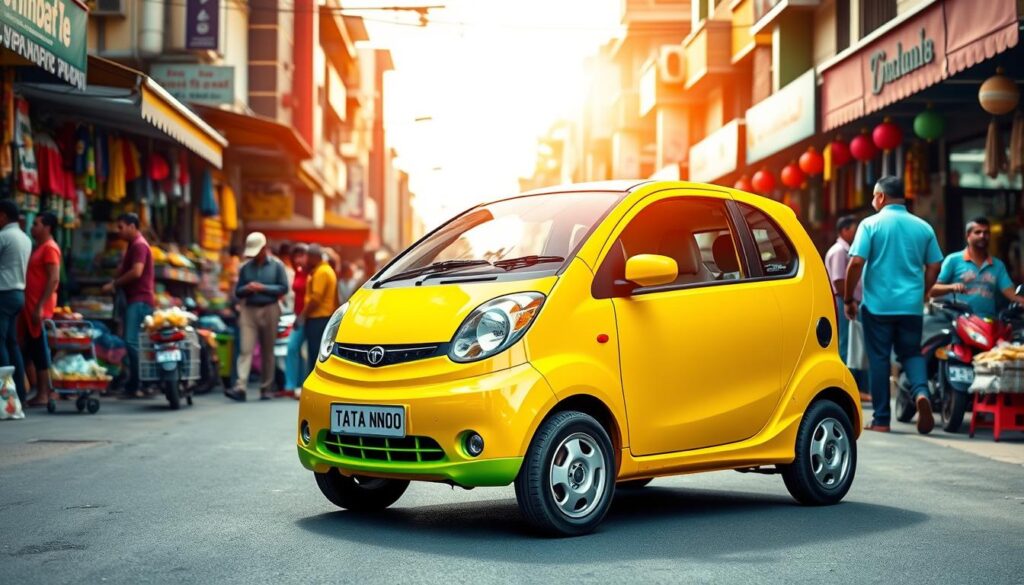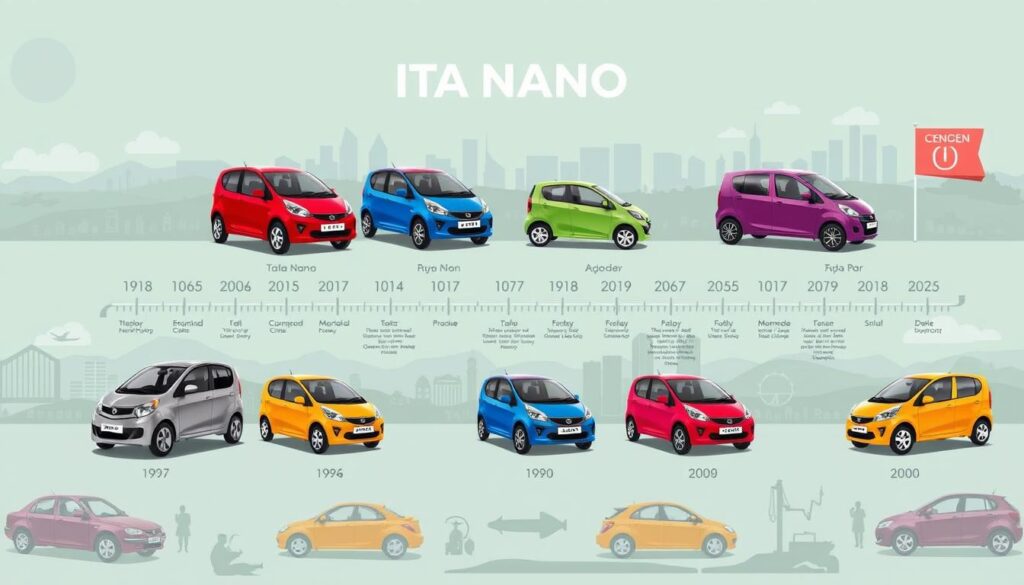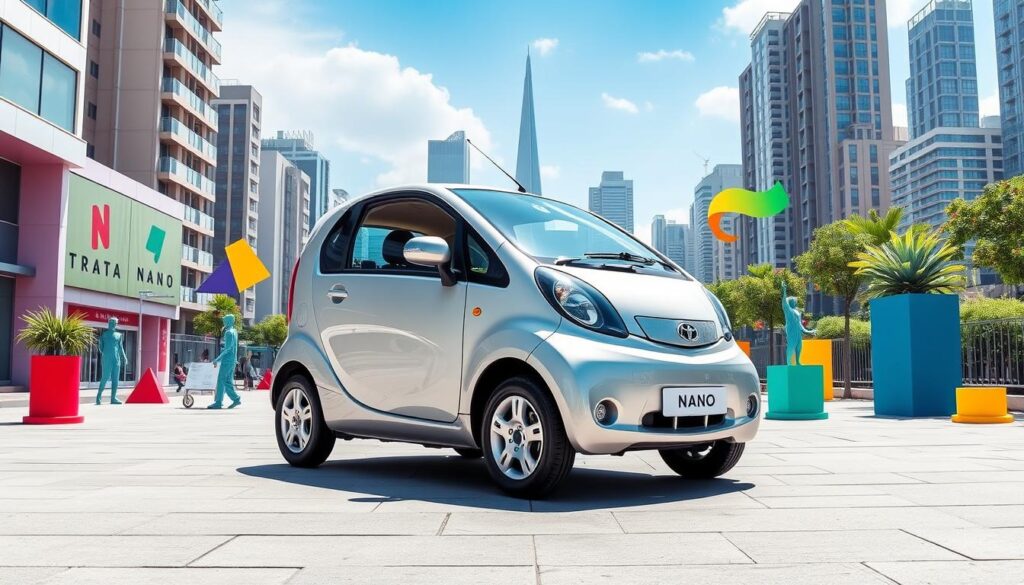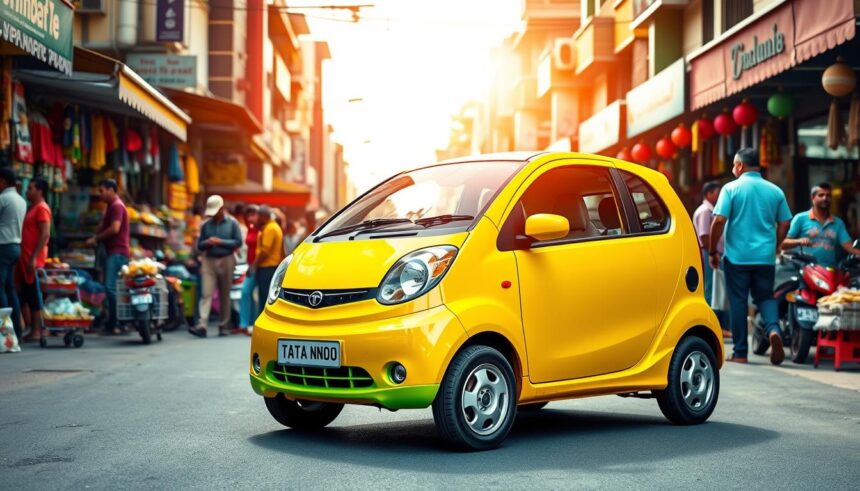I remember the excitement in India when the Tata Nano was first shown. It was a car that changed how we think about getting around. For many, it was a dream come true for affordable cars.
Looking back, I feel a bit nostalgic. We all waited eagerly for the Nano’s launch. It was a compact wonder that captured our hearts.

Key Takeaways
- Tata Nano was a pioneering initiative to provide affordable mobility for the masses in India.
- The car’s revolutionary price point made it accessible to a wider segment of the population.
- Tata Nano’s compact size and fuel-efficient engine made it a practical choice for urban commuting.
- Despite initial enthusiasm, the Nano faced challenges in terms of market acceptance and sales volumes.
- The discontinuation of the Nano model marked the end of an era in the Indian automotive industry.
The Vision Behind Tata Nano’s Creation
Ratan Tata, a visionary industrialist, dreamed of making cars affordable for middle-class families in India. He wanted to create a small car that every family could own. This car was meant to be a “people’s car,” improving lives by making cars affordable.
Ratan Tata’s Dream of Affordable Mobility
Ratan Tata, former chairman of Tata Motors, aimed to make cars affordable for all in India. He saw the Nano as a way to help the growing middle class move from two-wheelers to cars. His goal was to make a safe, fuel-efficient, and reliable car for the common man.
The People’s Car Initiative
The Tata Nano was part of Tata’s “people’s car” initiative. It aimed to change the auto industry by making cars affordable for more people. Tata’s team worked hard to design a car that met Indian market needs, focusing on cost and innovation.
Revolutionary Price Point Strategy
In 2008, Tata Motors launched the Tata Nano, the world’s cheapest car, at just one lakh rupees (about $2,500). This low price was thanks to smart engineering and efficient manufacturing. The Nano was designed to be small and fuel-efficient, appealing to budget-conscious buyers in India.
| Year | Price |
|---|---|
| 2008 | ₹1 lakh (approximately $2,500) |
| 2011-2018 | Varied across different models |
The Tata Nano’s low price and focus on affordability were key to Ratan Tata’s vision. The car’s design and engineering aimed to meet the growing need for personal transport. It made car ownership possible for more people.
“The Tata Nano was conceptualized to fulfill the dream of providing affordable mobility to the masses in India.”
Understanding Tata Nano’s Market Position
The Tata Nano was made to be an affordable car for India’s growing middle-class. It was meant for first-time car buyers. The Nano was called the “people’s car,” aiming to change the Indian car market with a cheap option.
When it launched in 2008, the Nano was priced at 1 lakh Rupees, or about $1,400. This made it the cheapest car in India. It was hoped to attract India’s low-income people who mostly used two-wheelers.
But, the Nano had problems like engine issues and not enough room. These issues hurt its appeal. The final price was around 2.59 lakh Rupees, much higher than expected.
Despite these issues, the Nano was seen as a good choice for city driving. It was fuel-efficient and small. It got about 200,000 bookings, showing people wanted an affordable car.
Compared to the Maruti Alto, the Nano was cheaper. The Nano’s top model was about 2.6 lakh Rupees in Bangalore. The Alto was more expensive. This made the Nano seem like a better deal.
But, the Nano’s sales dropped over time. It went from 74,527 units in 2011-12 to 7,591 in 2016-17. It stopped making cars in 2018. The reasons included bad publicity, safety worries, and not being seen as desirable.
The Tata Nano’s story in India’s car market is a lesson. It shows how important it is to check the market, position your brand right, and understand what buyers want. This is key in India’s fast-changing car industry.
Tata Nano Price Evolution Through Years
The Tata Nano, India’s most affordable car, saw a big price change from 2008 to 2018. It was a small car that aimed to make cars more accessible. It was priced low to fit Ratan Tata’s dream of a “People’s Car.” Let’s look at how the Tata Nano’s price changed over time.
Initial Launch Price (2008-2010)
The Tata Nano started in January 2008 for just ₹100,000 (US$2,500). It was one of the cheapest cars in the world. But, by 2017, the price went up to ₹215,000 ($3,400 US) because of higher costs and more features.
Price Variations Across Models (2011-2018)
Tata Motors changed the Nano’s price a few times. This was because of higher material costs and stricter emissions rules. In 2010, the price went up by 3-4% because of these changes. By 2017, the price hit ₹215,000 ($3,400 US).
Even with price changes, the Tata Nano was very affordable. The Nano GenX model came out in 2015 with new features. But, it didn’t boost sales as much as hoped.
Final Price Range Before Discontinuation
The Nano stopped being made in May 2018. But, its prices changed a lot before that. By the end, the Nano cost between ₹215,000 ($3,400 US) and ₹297,000 ($4,700 US), making it very affordable.
The Nano’s price changes show Tata Motors’ effort to keep it affordable. Despite challenges, the Nano’s impact on India’s car market is big. It paved the way for future car innovations in India.
| Year | Price Range (Petrol) | Price Range (CNG) |
|---|---|---|
| 2008-2010 | ₹100,000 – ₹205,000 | ₹240,000 – ₹260,000 |
| 2011-2014 | ₹215,000 – ₹255,000 | ₹250,000 – ₹270,000 |
| 2015-2018 | ₹225,000 – ₹289,000 | ₹260,000 – ₹297,000 |

The Tata Nano’s price changes show Tata Motors’ dedication to affordable cars in India. It followed Ratan Tata’s dream of making cars more accessible. Despite challenges, the Nano’s legacy inspires new car innovations in the Indian automotive industry.
Competitive Advantages of Tata Nano
The Tata Nano was known as the world’s cheapest car. It had many good points that made it stand out. Its small size was perfect for city driving, making it easy to park and move around.
It also used very little fuel, up to 37 kilometers per liter. This made it a great choice for people who wanted to save money.
The Nano was very affordable. Tata Motors made it cheap to attract first-time buyers and those who couldn’t afford more expensive cars. It was a reliable and affordable way to get around for many people.
Its design and size were also big pluses. The Nano looked different and was easy to handle. This made it appealing to those looking for something new and different.
| Competitive Advantage | Description |
|---|---|
| Compact Size | The Nano’s compact size made it ideal for urban driving, with excellent maneuverability and easy parking. |
| Fuel Efficiency | The Nano achieved impressive fuel efficiency, with reports of up to 37 km/l, making it an economical choice. |
| Low Price | Tata Motors positioned the Nano as the world’s cheapest car, targeting first-time buyers and those from lower-income classes. |
| Unique Design | The Nano’s distinctive appearance and compact dimensions helped it stand out in the entry-level car segment. |
Even though the Tata Nano faced some challenges, it was a great choice for many. Its size, fuel use, and price made it perfect for city living and saving money.

Features and Specifications Analysis
The Tata Nano shows great attention to detail in its engineering. It’s priced between Rs 2.26-3.20 lakh. Its rear-mounted 624cc petrol engine has 38 PS of power and 51 Nm of torque. Tata’s team worked hard to make the Nano efficient and powerful, despite its small size.
Engine Performance and Mileage
The Nano’s engine is a sign of Tata’s focus on saving fuel. It has a 5-speed gearbox for smooth driving. The car also has great mileage, making it a good choice for those watching their fuel costs.
Interior Space and Comfort
The Nano has a big interior for its small size. It’s designed to fit four adults comfortably. It also has a 94-litre boot for carrying things, showing Tata’s commitment to practicality.
Safety Features Overview
The Nano’s safety features are basic but meet the necessary standards. It has seatbelts, crumple zones, and a strong frame. These features are suitable for its price and the needs of its users.
FAQ
What are the key features and specifications of the Tata Nano?
The Tata Nano is a small car made for city driving. It has a tiny engine but lots of room inside. Its design is all about making the most of space without being too big.
It has basic safety features, but they’re enough for city driving. This car is all about being affordable and practical for city folks.
What are the competitive advantages of the Tata Nano?
The Tata Nano is great for city driving because it’s small. It also gets really good gas mileage, up to 37 kmpl. Plus, it’s one of the cheapest cars in India.
Its design and engineering set it apart in the entry-level market. It’s perfect for first-time buyers or anyone who wants a cheap city car.
How did the Tata Nano’s price evolve over the years?
The Tata Nano’s prices changed over time. The petrol versions cost between Rs. 2.05 lakh and Rs. 2.89 lakh. The CNG versions were priced from Rs. 2.40 lakh to Rs. 2.97 lakh.
These prices made it very affordable, fitting Ratan Tata’s goal of making cars accessible to all.
What was the vision behind the creation of the Tata Nano?
Ratan Tata wanted to make a car that middle-class families could afford. He dreamed of a car for every family, making it truly for the people.
His vision was to make life better by giving people an affordable car. It was all about making mobility accessible to everyone.
How does the Tata Nano position itself in the Indian automotive market?
The Tata Nano is for first-time buyers and middle-class families. It’s affordable and designed for city driving. Its fuel efficiency and low maintenance costs appeal to those on a budget.
